“If you see any image of the woods in any children’s book, you’ll probably see mushrooms,” author and illustrator Elise Gravel tells me over the phone from her home in Montreal. “We just love drawing them.” She’s specifically talking about the fly agaric, a toxic red-cap mushroom with white spots, perhaps most famous for providing Mario with growth spurts in the classic video game and which has been a staple in picture-book illustration since then for its cartoonish appearance.

The fly agaric is just one of many mushrooms that Gravel brings to life in The Mushroom Fan Club (Drawn and Quarterly, $20, 56 pages). She also features chanterelles and morels alongside more alien-like species with names such as the Dog Stinkhorn or the Destroying Angel. Although the fungi are anthropomorphized with cartoon eyes and goofy grins, the research behind the book is real. Gravel has created a scientific intro book for budding mycologists, combining picture-book artwork with facts about boletes (some turn blue when touched) and the Lactarius indigo (which produce a milk-like substance when cut open).
Gravel’s cuddly little mushrooms first made their appearance in If Found … Please Return to Elise Gravel, a sketchbook of the prolific author and illustrator’s many obsessions published last year with Drawn & Quarterly, although she’s had an interest in them for years. Around seven years ago, she and a friend took an introductory class given at a botanical garden in Montreal centred on identifying local species of mushroom. “We were hooked after that,” she said. “We wanted to know what everything was.” She continues to regularly forage for mushrooms with her daughters and friends.
The Mushroom Fan Club – which aside from identifying different types of fungi also includes a diagram of the parts of the mushroom, a tutorial on making “spore prints” and advice on how to start hunting for mushrooms at home – is a book that plays to Gravel’s strengths. Although she has a solid bibliography of traditional picture books to her name, it’s these non-fiction books that combine biology with a comic aesthetic where her work really comes to life. This latest book sits comfortably in the tradition of the Disgusting Critters series she published with Tundra. Every book in that series takes a look at an oft-maligned creature – the slug, the spider, the head louse – and casts them as the star in their own story, interspersing facts with what they eat and where they live with sight gags and punchlines.

“I always liked bugs and little critters, and felt bad for creatures that everybody found disgusting,” Gravel said. “I thought they were cute, and was always observing them and trying to imagine their personalities.” She read whatever books about them she could get her hands on, although it wasn’t until her own daughters were born that she decided to bring her artistic sensibilities to the subject so she could share her curiosity and enthusiasm with a new readership. “They should be respected like any other creatures. They’re important to the ecosystem. I realized, kids don’t grow up with this disgust. We teach them that. I wanted to teach them open-mindedness toward all creatures.”
The Disgusting Critters series turned out to be wildly popular with young readers and educators alike. Gravel is frequently contacted by teachers with requests to write more of them. The Mushroom Fan Club shows early signs of a similar response. Parents send Gravel pictures of their kids drawing mushrooms, or off on their own mushroom-hunting adventures. The ardour with which Gravel approaches her subject matter is on the surface of every page (“fan club” is right there in the title, after all), and as if the spores of a puffball mushroom, it spreads easily. The Mushroom Fan Club, like The Disgusting Critters before it, gives its young readership permission to indulge in their innate curiosities and to approach the natural world around them with a fascination reserved for storybook creations.
“I first thought, maybe we’re tricking kids into learning stuff,” Gravel said, “but the thing is, they’re not tricked. They write me letters saying, ‘You learn stuff, but at the same time you laugh.’ They know they’re learning and they love it.”